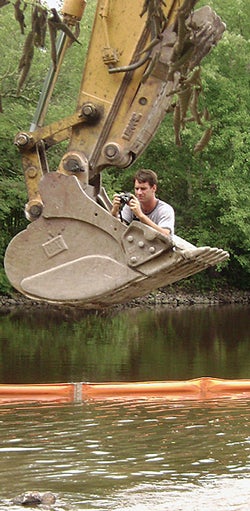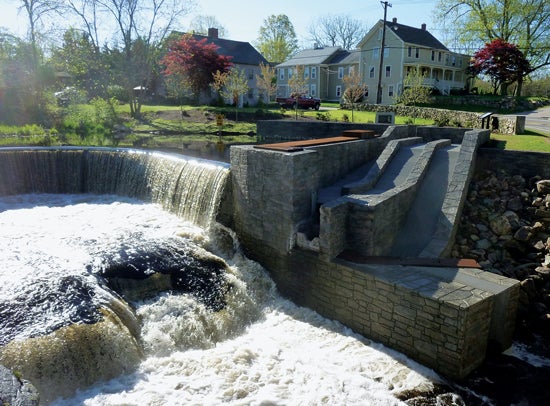Turning Back Time
Herring, unlike the rest of us, actually like to swim upstream. For centuries, however, their path up the Pawcatuck River was blocked. Now, a restoration effort means their epic migration is once more returning to the river.
By Paul Kandarian
Update: Chris Fox ’96 sent us this wonderful video (produced by our own Ayla Fox ’11) of river herring making their way to Worden Pond last weekend. Enjoy! (March 31, 2016)
Herring, a staple fish for Native Americans and colonial farmers, were once a familiar sight wriggling their way up the Pawcatuck River to spawn. But then the Industrial Revolution came to Connecticut and Rhode Island, through which the Pawcatuck flows. Dams were built to power 18th Century mills. The herring, unable to make their way, disappeared.
They’re back. Beginning in 2010, three fish passages were established along the Pawcatuck’s length. With the seeding of Worden Pond in South Kingstown, where the fish begin life, young herring begin their mysterious 32-mile journey to the ocean near Watch Hill in Westerly. They will reach sexual maturity after three to four years in the ocean, and return to the pond every April to spawn. It’s a cycle of life that was interrupted for centuries, and its restoration owes much to Chris Fox ’96.
Fox, an environmental sciences major who is now executive director of the Wood-Pawcatuck Watershed Association, spearheaded an effort that included removing a dam at Lower Shannock Falls; creating a state-of-the-art fish ladder for herring and eels at Horseshoe Falls; and diverting the river at Kenyon Industries to install a series of rock ramps for easier fish navigation.

“Three fish ladders now exist on a 32-mile stretch of river from here to Westerly,” Fox says, standing on a strategically located boulder in the rushing waters at Lower Shannock Falls. “At a cost of $4.2 million. Or, way less than Taylor Swift paid for her mansion in Watch Hill.”
Fox, a rural Cumberland native who, as a kid, dug trenches to drain storm puddles in the road, is quick with a joke. But it’s no joke that his efforts led to undoing an environmental wrong committed centuries ago.
“The Industrial Revolution needed dams. There was need and necessity when those dams were built,” he says. “But when there’s not, there’s an obligation to set things right.”
Engineering started in 2008 and the dam at Lower Shannock Falls was removed in 2010, the first permitted dam removal in Rhode Island—a state that Fox says has some of the strictest environmental regulations in the country.
Fox’s main job, besides finding funding for the project—it largely came from federal stimulus money—was corralling the efforts of some 14 federal, state and local agencies. He got help from two key Watershed Association board members, URI environmental science professor Peter August and Alan Desbonnet, assistant director of URI’s Sea Grant Program.
Fox also played diplomat, working with river abutters to assure them the project was for the best, going as far as to drill a new well for a homeowner whose existing well would likely dry up when the river flow was altered.
The dam at Lower Shannock was removed in stages, and tons of sediment scraped out. Boulders were placed in key points to create a natural fish passageway with small resting pools for the fish, a very precise operation that involved gauging the speed and flow of the water from decades-old data.
“We put compact-car sized boulders in place to within a quarter-inch tolerance,” Fox says. “An added benefit is the eels and brook trout can get through now, too, and it’s a far easier portage around for kayakers and canoeists.”
The second phase was at picturesque Horseshoe Falls in Shannock Village, where a high-tech fish ladder was installed, including a separate passageway for eels, which are also making a comeback.
Part of the work was creating a one-of-a-kind gravity-fed device for eels to pass through, with bristles on one side for small eels, and thimble-shaped versions on the other for larger eels to wiggle through.
“This was the most technical part,” Fox says of the intricate project. “We had to build a concrete static structure in an ever-changing environment, which lies between a scenic highway and an iconic old dam.”
At Kenyon Industries, work involved diverting the river to create a gently sloping series of ramps, then moving the water back. An added benefit: Kenyon got a brand new dam at no cost, vital to supplying water to its fire-suppression system, and a series of hydrants were built on the river for local fire departments.
Phil Edwards is a fish biologist for the state Department of Environmental Management, which now owns and maintains the innovative structures. The DEM has been stocking Worden Pond since 2012 in anticipation of what Edwards found this spring: herring, returning to their place in the river’s ecosystem as an important food for larger fish, herons, cormorants and osprey.
“We saw fish—some counts were about 100 an hour,” Edwards says. “We’re very excited, and grateful.”
For Fox, it’s the culmination of years of tireless advocacy—and, he hopes, a good sign for the future. The national attention that the project has won could help the Wood-Pawcatuck Watershed Association realize its ultimate goal, and the reason it was first created in the 1980s: winning a Wild and Scenic Rivers designation. The federal program helps protect rivers that generate tourism and recreation revenue, and could support further environmental revitalization efforts, from migratory fish passages to flood mitigation plans. Fox says he’s only playing a role in the river’s natural transformation. “I feel extremely fortunate,” he says, “to have a hand in facilitating the river’s transformation from primarily serving industry, to evenly serving the people and the wildlife that rely on it.” •

 Home
Home Browse
Browse Close
Close Events
Events Maps
Maps Email
Email Brightspace
Brightspace eCampus
eCampus


